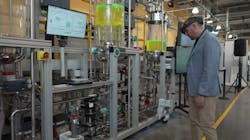Digital Twins, Testbeds Put Pain Points To Rest
Digital twins can be central to strategies for optimizing supply-chain sustainability and emissions management. Indeed, BASF, NOVA Chemicals and Aveva have found success in applying knowledge learned in the digital environment.
Siemens USA and Dow Chemical also are helping companies keen to learn how to apply digital twins to their own processes. The two companies are 18 months into an initial six-year collaboration to develop a digital twin and augmented reality (AR) process manufacturing testbed located at MxD’s innovation center in Chicago.
The testbed offers hands-on demonstrations of how a digital twin, AR and internet of things (IoT) devices can come together with hardware to accelerate digitalization in process industries. It lets users see how they can design, monitor and maintain their products more effectively and efficiently, and even do it remotely using data and digital tools.
“As the industry operator representative for the team, Dow was instrumental in contributing to the design specifications for the capabilities, requirements, and use cases for the process testbed. Our engineers worked alongside the other team members’ representatives to help ensure collective project success,” explains Billy B Bardin, global digitalization director, Dow, Lake Jackson, Texas.
“The process testbed was designed to be a flexible, configurable, and agile system that will support many test-use cases and serve as a base platform for studies to develop new technology in hardware, software, data architecture and process control. It has the potential to be combined with other capabilities on the MxD factory floor to further expand its development opportunities. We expect member companies will bring specific use cases or pain points that can be explored using the testbed,” Bardin adds.
At the same time, Bardin emphasizes that every company is on its own digitalization journey and as such must determine what level of investment in technology is needed to generate value. So before thinking about the tools available on the market, process companies must consider which use cases will bring a return on investment.
“The process industries have had many types of models, many of which could be considered digital twins in today’s vernacular, for decades and have been utilizing them to optimize operations. It is no surprise that each individual company must determine the appropriate level of investment in digital capabilities. Small- to medium-sized enterprises may use the capabilities at the advanced manufacturing institutes, like MxD, to gain access to a wide variety of solutions that can help advance their operational excellence and learn best practices from larger operators as well as solution providers,” he said.
So far, the testbed has garnered much interest from process industry companies, a number gathering for a recent workshop on digitalization. Here, many companies identified with the use cases, such as connected mobile workers, remote work instructions, and virtual process models that would help benefit their operations productivity, reliability, and, importantly, safety, among many key performance indicators, Bardin noted.
Iiro Esko, chemical industry manager, Siemens Industry, process automation, Houston, concurs.
“Feedback from the field has been positive when it comes to modularity, openness and relevance of the dozen technologies that are for show. What you see on the skid is based on what is available on the market, how it plays together, and how it adds value. Testbed, commercial offerings, and promotion materials such as videos, virtual tours, and presentations all align to lower the total cost of data access for front-line workers and help to retain and hire skilled workforce,” he says.
To address the needs of large corporations, small start-ups and everything in between, Siemens recently launched Xcelerator, an open digital business platform that enables companies to find the best technologies to address their business challenges, and stay within budget; some of technologies showcased on the testbed are also available on Siemens Xcelerator.
“Evaluations of process industry plants through expert visits and workshops is a good way to find low-hanging fruit to counter any concerns or issues related to the cost of digital transformation,” adds Esko.
He emphasizes that the testbed is designed to show what can be done using digital twins and other digitalization technologies to address real-world mobile worker use cases. All the use cases demonstrated on the process industries testbed can be addressed with commercially available tools today (Lead Image: All the use cases demonstrated on the MxD process industries testbed can be addressed with tools that are commercially available today.)
“MxD works with companies to create new projects, based on different data sets, solving and finding suggestions for real-life issues. The testbed is prepared for any future additions or expansion – two of these are virtual reality and modular automation, which will be added in the near future,” notes Esko.
While MxD is based in the United States, and provides a space for end users to share their needs with suppliers so that best technologies can be collaboratively created, Siemens has similar testbeds available in Europe and Asia.
“Market trends and customer feedback indicates that web-based technologies are a fast-track to transforming the reality at process plants and those of us that work in that space,” Esko concludes.
DIGITAL TRACERS IN RECYCLED PLASTIC
In June, BASF Canada, Mississauga, Ontario, announced an expansion of its reciChain recycled plastics tracking platform in Alberta, Canada.
Originally created by BASF in Sao Paolo, Brazil, a 2020 proof-of-concept pilot carried out in British Columbia, Canada, proved circularity by using reciChain to track plastics’ lifecycles from pellet to pellet.
The program relies on two technology components. The first is a physical tracer that identifies and follows key plastic features throughout the value chain and enables the connection of plastic to a digital twin.
The second is a blockchain marketplace developed by Real Items, San Francisco, which creates and translates the digital twin, providing a secure, auditable transfer-of-ownership and assigning incentives to encourage participation and offset costs.
BASF also is partnering with supply-chain digitalization and blockchain specialists Optel, Québec; and Security Matters, Melbourne, Australia, to develop novel barcoding systems capable of withstanding the stresses of manufacturing and recycling processes.
In the case of Security Matters, this includes a marker embedded into both rigid and flexible plastic that allows users to access and verify information associated with the material.
Using digital tracers, these barcodes capture information needed to authenticate sustainability claims and make sorting more accurate.
The Alberta phase of the project aims to take reciChain to a semi commercial phase. It includes organizations involved in all aspects of plastics value chain, including local companies NOVA Chemicals and Orion Plastics, plus waste and recycling services from Calgary and Edmonton.
Involved since the beginning of reciChain, NOVA Chemicals (Figure 1) continues to offer technical expertise and product donations — polyethylene (PE) resin — to enable the feasibility of the program.
“As supplier of PE, a readily recyclable plastic in a wide variety of packaging, we help with managing the project and assisting other participants with the trial design and execution,” explains Paul Tas, director of polyethylene technical services.
“While the initial project was a proof of concept, this one is aimed at truly implementing reciChain on a larger scale. The project intends to drive a circular economy, and the consumer is a large part of that. One of challenges we overcame was making sure that the solution works throughout the entire value chain. The beauty of a project like reciChain is that we have experts in every field needed to create a circular economy,” he adds.
Meanwhile, according to a BASF spokeswoman, the next steps in reciChain’s development will progress once the company has settled on a physical tracker technology to use with the platform.
SCALING DOWN EMISSIONS
“Today’s field-proven software allows chemical companies to radically optimize their businesses while also calculating greenhouse gas (GHG) emissions and minimizing energy consumption, so helping address Scope 1, 2 and 3 emissions,” says Stephen Reynolds, industry principal — chemicals, Aveva, Cambridge, U.K.
“The digital twin runs a parallel operation to your plant in the digital environment. When it is combined with real-time operational data, it can predict behavior with accuracy through first principal models and artificial intelligence (AI). These insights then give your teams a window into ways to improve your processes and optimize operations,” he adds.
One possible approach to energy and emissions management is through rigorous modeling to calculate emissions reduction potential to stabilize and optimize operations. The reduction potential informs teams of the true actionable gap that can be addressed and the limits that can be reached. Improving the energy mix to maximize use of clean energy is desirable, too, but not every plant has this option.
Next, says Reynolds, is improving asset reliability to minimize excursions. Many industrial processes generate more GHG emissions during start-up and shutdown procedures, not to mention during accidents, so minimizing or eliminating unplanned downtime is critical for keeping carbon footprint under control.
“AI and machine learning (ML) models enable early-warning notifications that can prompt your staff to act in time to prevent unplanned shutdown and accidents. To take a step further, you can add inferences from rigorous models and calculate the RULE [remaining useful life estimation], adding predictions accuracy and anticipating notifications even further. This approach combined with an asset strategy optimization can ensure maximum reliability at minimal costs,” he says.
The latest digital-twin technology also allows users to minimize project risks and ensure the plant is delivered on budget and schedule with an effective handover to operations. This, notes Reynolds, is a critical aspect for maximizing the return on investments in digital technology.
With reliable access to plant data and effective modeling capabilities, users should also be able to identify if an upgrade is required to manage GHG emissions and energy usage. So, the unified approach can be used for greenfield and brownfield projects.
“By combining your operations and engineering data, you’ll be able to evaluate options to upgrade your assets to reduce your GHG emissions even further or be able to incorporate flexibility in the energy mix so clean energy usage can be maximized,” Reynolds explains.
Nevertheless, Reynolds believes the biggest challenge industrial companies will face is probably to address Scope 3 emissions. Scope 3 covers emissions not produced by the company itself, but by those that it’s indirectly responsible for, up and down its value chain. “Managing upstream and downstream emissions is not an easy task,” he notes.
“The first step is certainly having visibility of the carbon footprint. Data sharing across your ecosystem can be beneficial to your company as well as suppliers, customers and partners. Only with full visibility can companies identify the need to purchase carbon credits and carbon negative options.”
This, he says, can be addressed with a fully managed cloud-native solution that enables knowledgeable experts who can enrich data streams with metadata and context to help other users understand and make sense of the data. From this, it is possible to create a master plan and develop a roadmap for net-zero. Using data to make better decisions is more and more a core function of business and society. Data is increasingly helping to solve complex problems such as managing and optimizing resources to address Scope 3 emissions.
Reynolds also stresses that none of this is possible without duly empowering the workforce: “Digital technology is the number one enabler for engineers in the office, operators in the control room, field workers on the plant floor, anytime-anywhere remote workers and, of course, the leadership team that requires deep 360-degree visibility into the enterprise.”
“The digital twins of the future will empower low-carbon remote working, safe and productive working styles, real-time carbon insights, and augmented decision making for optimized carbon footprints,” he concludes.
About the Author
Seán Ottewell
Editor-at-Large
Seán Crevan Ottewell is Chemical Processing's Editor-at-Large. Seán earned his bachelor's of science degree in biochemistry at the University of Warwick and his master's in radiation biochemistry at the University of London. He served as Science Officer with the UK Department of Environment’s Chernobyl Monitoring Unit’s Food Science Radiation Unit, London. His editorial background includes assistant editor, news editor and then editor of The Chemical Engineer, the Institution of Chemical Engineers’ twice monthly technical journal. Prior to joining Chemical Processing in 2012 he was editor of European Chemical Engineer, European Process Engineer, International Power Engineer, and European Laboratory Scientist, with Setform Limited, London.
He is based in East Mayo, Republic of Ireland, where he and his wife Suzi (a maths, biology and chemistry teacher) host guests from all over the world at their holiday cottage in East Mayo.


